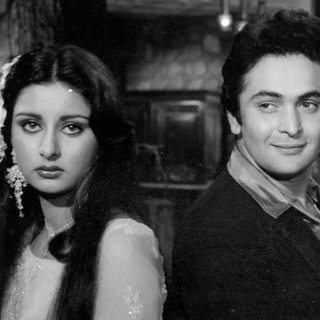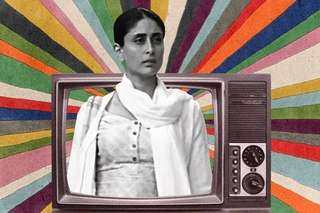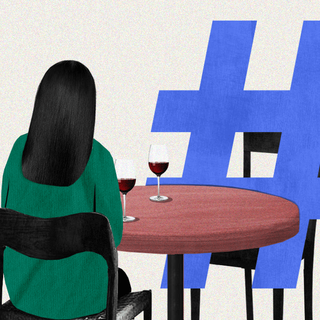
Can We Move On: From the Trope of the Woman Who Has a Makeover to Match a Big Life Change
Are you really in love if you haven’t replaced your entire wardrobe with red, flowy dresses?

In Can We Move On, we revisit old tropes and question whether they have any remaining cultural relevance.
Growing up, I absolutely loved Jab We Met. After watching the movie, I remember wanting to dress up like Kareena Kapoor’s character, Geet, accessorize like her, and every once in a while, insert “Main apni favorite hoon!” into conversations. I didn’t quite succeed at the latter because, honestly, how many times does real-life throw you opportunities to say that you unabashedly love yourself? But I’d like to think that I nailed the first two — at least, as well as my teenage self with limited financial resources could.
However, when my then-boyfriend broke up with me, I wanted my wardrobe to reflect my heartbreak — just like Geet’s did. In the second half of the movie, she passed her brightly-colored, boisterously-embroidered clothes for muted, mostly monochromatic salwars and cardigans after a heartbreak. But much to my disappointment, I had to come to terms with the fact that real people, in real life don’t change their wardrobes overnight. Until then, I had somehow never questioned the entire look of women characters’ suddenly transforming to match big changes in their life.
Despite there being little credibility to this trend of people changing their wardrobes overnight to match big changes in their lives, Hindi movies have shown this transformation most faithfully when it comes to women on screen. In Kal Ho Naa Ho (2003), for instance, Priety Zinta’s character, Naina, not only gets rid of her glasses after she falls in love with Shah Rukh Khan’s character, Aman, but also appears to have changed her sense of style. In Queen (2013), too, Kangana Ranaut’s character, Rani, undergoes a gradual sartorial overhaul as she moves on from her fiancé and realizes she doesn’t need a man to be happy.
Bollywood movies also have a tendency to suggest that the moment a woman gets married, she must absolutely revamp her entire wardrobe. To me, it has always seemed a way to show the person is someone else’s “property,” or paraaya dhan — much the same way people renovate or customize the houses they move into. Even here, the woman must transform in accordance with the tastes of her in-laws. The wedding trousseau is a thing, but it seems unrealistic that middle-class women would buy an entire wardrobe full of clothes— including comfort-wear reserved for home.
Related on The Swaddle:
Can We Move On: From the Trope of the Woman Who Perfectly Balances Sanskaar and Sexiness
Now, whether it was Bollywood that spawned the sexist notion that women must somehow look different after tying the knot, or the sexist notion itself that inspired Bollywood, we might never know. It’s a classic case of “which came first: the chicken or the egg?” Perhaps, patriarchal markers of a woman’s marital status — like kumkum, mangalsutra, ghoonghat, or certain kinds of bangles and toe rings, among others — inspired Bollywood to go all out and give women full post-wedding makeovers. And given that we live in a country, where just in 2020, a High Court ruled that a married woman’s unwillingness to wear a shaakha and apply sindoor “signifies her refusal to accept her marriage.” It is no wonder then audiences lapped up the idea of a distinct post-wedding look to convey a change in “ownership” over women’s bodies.
But, arguably, after years of being conditioned by Bollywood movies like 2001’s Kabhi Khushi Kabhie Gham, 1999’s Hum Saath-Saath Hain and Hum Dil De Chuke Sanam, and 1998’s Kuch Kuch Hota Hai, it’s not unlikely that they have reinforced our idea that women should “look married.”
It’s not just their love lives — or marital statuses — that control the fashion choices of Bollywood’s women though. In Laaga Chunari Mein Daag (2007), for example, when Rani Mukherjee’s character, Vibhavari, decides to become a “high-level escort,” she overhauls her wardrobe. But, at least, the movie makes an attempt to justify it by showing her change her cahnge entire identity — yes, including her name too — to fit in with her upper-class clientele. In the context of the plot, it seems only fair she discards her erstwhile wardrobe that reflected her transition from a tier-two-city woman to one who lives in a metropolis and hangs out with its most elite crowd.
Similarly, in Chori Chori Chupke Chupke (2001), too, Priety Zinta’s character, Madhu, undergoes a transformation. But the filmmakers rationalized it by suggesting it was an endeavor to present her as a person from a more “refined” background — as problematic as that was. And she is actually given Rs. 50,000 for the sole purpose of revamping her wardrobe. For context, its inflation-adjusted value at present would be close to Rs. 2,00,000.
The passage of time, too, is another way for movies to justify sweeping changes in the fashion sense of individuals. That’s how movies like Yeh Jawaani Hai Deewani (2013), Mere Brother Ki Dulhan (2011), and Kuch Kuch Hota Hai explained the rather monumental changes characters played by Deepika Padukone, Katrina Kaif, and Kajol made respectively — maturing over time into a rather impeccable fashion sense.
Related on The Swaddle:
Can We Move On: From the Sexless, Sacrificing Divorced Woman Trope
It makes sense that filmmakers would use wardrobes of their leading ladies as devices to support the narrative. But the extent of transformation female characters undergo, often doesn’t. Commenting on Shraddha’s Kapoor’s character from Batti Gul Meter Chalu (2018), film critic Sucharita Tyagi pointed out how “she loses her entire sense of fashion in the second half of the movie.”
“It’s one thing giving your characters subdued colors to wear to show [that life is suddenly bereft of joy], but it’s a whole different thing changing their entire sense of style,” Tyagi continues. “She’s seen wearing sarees with the strangest-looking sweaters — something that the character, [which you have established so far], doesn’t even own.” Given that Kapoor’s character had been set up as that of “a small-town Katrina Kaif,” who is an aspiring designer and hopes to showcase her designs at Lakmé Fashion Week one day, this critique cuts to the core of this sartorial relationship.
To Main Hoon Na‘s credit though, Amrita Rao’s character donned her old clothes in college from time to time after making a quintessential Bollywood-style entrance in her pink suit that inspired Tumse Milke Dil Ka Hai Jo Haal… The makeover itself furthers a sexist idea of how women must dress so as to seem attractive to cis-het men — just like a million movies, from 1986’s Naseeb Apna Apna to 2010’s Aisha have. However, the fact that Rao’s character didn’t just throw out all of her old clothes seemed oddly practical for a Farah Khan movie.
Not only that, the idea that a woman’s attire must reflect her grief also results in real women being trolled and criticized for not dressing to grieve — just like Mandira Bedi was in 2021 and Rhea Chakraborty in 2020.
This also makes me wonder about a rather logistical issue that comes with revamping wardrobes: what happens to people’s old clothes? This question doesn’t keep me up at night, but, I do occasionally wonder if these fashion overhauls give a not-at-all needed impetus to consumerism at a time when environmentalists are imploring people to stop buying new clothes.
At best, the trope of transforming wardrobes seems illogical; at worst, it reinforces regressive ideas. So, maybe, it’s time for us to move on from the trope of the woman who changes her entire look to reflect big changes in her life.
Devrupa Rakshit is an Associate Editor at The Swaddle. She is a lawyer by education, a poet by accident, a painter by shaukh, and autistic by birth. You can find her on Instagram @devruparakshit.
Related


The Problem With Packaging Healthy Dating Practices as Internet Trends
